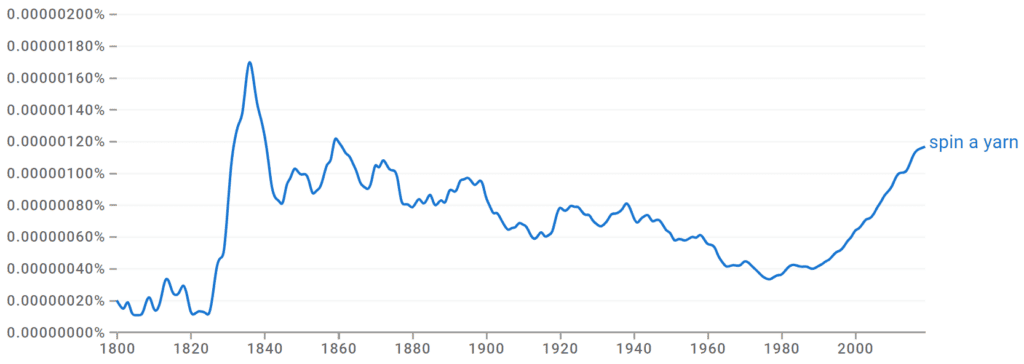To spin a yarn is a fairly young idiomatic phrase with nautical origins, but did you know it may be influenced by an even older analogous term?
Idiomatic words and phrases are figurative uses of what once was (and may still be) a literal definition of an event or action. They are great ways to provide another way of explaining something and are popular to use in all languages. However, they can be confusing to non-native speakers.
Let’s take a look at what spin a yarn means, where it originated, and how you can use it in speech and text.
What Is the Meaning of Spin a Yarn?

To spin a yarn is an idiomatic phrase that means to tell an unusually long and sometimes imaginative story. Occasionally, these stories can be rather creative in nature and possibly unlikely to have occurred—meaning the phrase is used as a way to cast skepticism on the teller of the tale.
A yarn is often considered a long story told primarily as a form of entertainment, not as a method of communicating important information.
For example:
- Before purchasing a used vehicle, make sure the agent isn’t spinning a yarn about the quality of your interests, and insist you have your own mechanic check it out.
- The police were used to suspects spinning a yarn about their involvement in various infractions, which is why they caution what they say when they read Miranda rights.
- The campers were asked to think of a time they were excited about something, but they had to spin a yarn with it when they shared and add in new, exciting details.
Spin a Yarn Origins

Most believe that the phrase spin a yarn was originally a nautical idiom in the 19th century. Seaman often had to spend time repairing rope onboard the ship. This time-consuming task involves twisting fibers together, which is alleged to have been referred to as “spinning yarn.”
While repairing rope, sailors would often tell each other stories to while away the time.
The figurative use of the word spin as a way to explain anything fabricated or produced in an analogous way related to spinning hails from the 1550s. Placing spin and yarn together as a phrasal idiom made sense and was likely used long before it was documented in the early 19th century.
The first documentation of the term was published in 1819 in the Memoirs of James Hardy Vaux:
“Yarning or spinning a yarn, signifying to relate their various adventures, exploits, and escapes to each other.”
It’s possible spinning a yard was influenced by the earlier use of spinning a thread. The word thread has long been used figuratively to explain a narrative train of thought and was possibly first documented in the 1300s in Kyng Alisaunder, a medieval romance:
“He hath y-sponne a threde, / That is y-come of eovel rede.”
Let’s Review
The idiomatic phrase to spin a yarn is likely influenced by the related term spin a thread, which was first used approximately 500 years before the first documented use of spin a yarn. Both mean to tell a story, one that is somewhat exaggerated, long or possibly made up altogether.
To spin a yarn became well-known as a nautical term in the 1800s and has long been associated with the practice of sitting around and telling a story to pass the time while otherwise engaged in a physical activity of sorts—such as spinning yarn (or thread) or other domestic tasks.
Want to have more idioms in your arsenal? Check out some others we covered:
